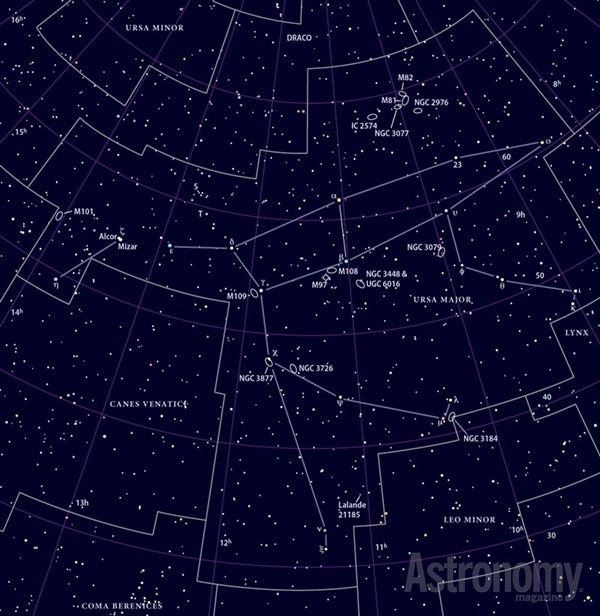Targets for February 27–March 6, 2014
Naked eyes: Regulus (Alpha [α] Leonis)
Small telescope: Bode’s Galaxy (M81)
Large telescope: Spiral galaxy NGC 2903
This week’s naked-eye object is Regulus (Alpha [α] Leonis), Leo the Lion’s brightest star. It’s easy to find in February low in the east after sunset.
But a closer look will show you that Regulus is more than Leo’s luminary. Through binoculars, you can spot a bright primary star and a fainter secondary.
Actually, Regulus is a triple star. It features magnitude 1.35 Regulus A — the night sky’s 21st-brightest star — and the much fainter pair B-C.
B shines at magnitude 8.1, and C glows faintly at magnitude 13.5, so you sure won’t see it through binoculars. Stars B and C lie 4.2″ apart, and the A component lies 177″ away from them. That’s nearly 3′, a pretty easy split through 10x binoculars. To see the third component, you’ll need an 11-inch telescope and a dark site.
Spiral masterpiece
This week’s small telescope target is one of the sky’s most famous deep-sky objects: Bode’s Galaxy in Ursa Major. You may know this spiral galaxy as M81.
To find it, point your telescope at the northwest section of the Great Bear. You’ll find the galaxy 2° east-southeast of the magnitude 4.5 star 24 Ursae Majoris. At magnitude 6.9, M81 is one of the sky’s brightest galaxies. It’s also large. It measures 24′ by 13′.
German astronomer and celestial cartographer Johann Elert Bode discovered this object, and nearby irregular galaxy M82, December 31, 1774. French astronomer Pierre Méchain independently discovered both galaxies in August 1779 and reported them to Messier, who added them to his list. I’ll talk about M82 in my next podcast.
Bode’s Galaxy glows brightly enough to show up through binoculars, but a 4-inch telescope will show you details no binoculars can. Look for a large, bright central region surrounding the much brighter core. If you can sneak a glance through an 11-inch instrument, you’ll detect how the spiral arms wind tightly around the core. The easternmost appears brighter. Unfortunately, you won’t detect any dust lanes or star-forming regions through amateur scopes of any size.
M81 is the brightest member of the M81 Group, one of the closest galaxy groups to our own Local Group. The M81 Group contains about a dozen galaxies and lies 12 million light-years away. Other members of this group include M82, NGC 2403, NGC 2366, and NGC 3077.
A beauty in Leo
This week’s large telescope target is spiral galaxy NGC 2903 in Leo. To find it, look 1.5° south of magnitude 4.3 Lambda (λ) Leonis.
Leo the Lion contains many fine galaxies, five of which (M65, M66, M95, M96, and M105) made Messier’s list. Don’t overlook NGC 2903, however, which, at magnitude 9.0, shines brighter than any Leo Messier galaxy except M66. NGC 2903 measures 12′ by 5.6′.
German-born English astronomer Sir William Herschel discovered NGC 2903 in 1784. I’ve always wondered why this bright, easily seen celestial wonder lacks either a Messier number or a common name.
Astronomers classify NGC 2903 as a “hotspot” galaxy, a term coined in the 1950s that describes a ring of infrared-luminous knots near a galaxy’s core. The knots are hot star clusters only 6 to 9 million years old.
Although NGC 2903 is a bright galaxy, you won’t see much detail through a telescope with an aperture smaller than 11 inches. Through an 11-inch scope, look for a halo 4′ by 2′ that surrounds a bright core. Close examination at high magnification reveals the galaxy’s central bar and the spiral arms, which aren’t much brighter than its halo. Through larger scopes, look for dust lanes and emission nebulae spread throughout NGC 2903’s spiral arms.
A second deep-sky object — NGC 2905 — appears as a bright knot within NGC 2903. NGC 2905 is a star-forming region, which Herschel assigned a second designation. It lies slightly more than 1′ north-northeast of NGC 2903’s core.
Expand your observing at Astronomy.com
StarDome
Check out Astronomy.com’s interactive StarDome to see an accurate map of your sky. This tool will help you locate this week’s targets.
The Sky this Week
Get a daily digest of celestial events coming soon to a sky near you.
Observing Talk
After you listen to the podcast and try to find the objects, be sure to share your observing experience with us by leaving a comment at the blog or in the Reader Forums.











